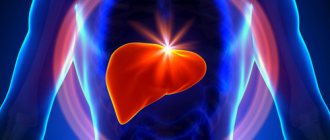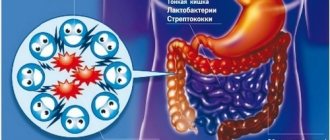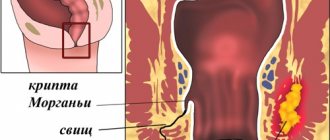Causes of yellow diarrhea
Deviations in the act of defecation require close attention and sometimes treatment. Bile takes part in the formation of feces, coloring them brown. Lack of liver product results in yellow stools. Another reason for yellow stool may be the rapid removal of feces from the intestines, which have not had time to form and acquire a natural color. The most common causes of loose stools:
- Viral and bacterial infections.
- Infection with staphylococci.
- Side effects of medications.
- Inflammation of the pancreas.
- Liver dysfunction. A lack of bile salt, which is responsible for the proper functioning of the digestive tract, contributes to the appearance of yellow liquid stool.
- Inflammation of the colon mucosa.
- Food intolerance.
- Hormonal disbalance. Yellow diarrhea in women can occur during menopause or pregnancy.
- Inflammatory changes in the gastric mucosa.
With salmonellosis, the stool has a dark yellow or green tint and mucus is present.
With dysentery, the stool is green and watery. Yellowish, loose stools that turn gray indicate rotavirus infection. Ulcerative colitis causes light yellow stools containing blood and pus. Bright yellow, foamy diarrhea can be caused by staph. Mustard-colored stool is caused by bacteria. With intestinal candidiasis, the stool is liquid with white flakes. A beige color indicates liver damage.
Orange, red stools are caused by eating foods containing large amounts of carotene. If such products are not consumed, the cause may be hepatitis, stomach ulcers, or cystitis.
Diarrhea may occur when changing water and food in travelers.
Yellow diarrhea due to poisoning
When the body is intoxicated, inflammation of the gastrointestinal tract occurs due to the entry, reproduction, death and decomposition of microbes. Such processes irritate the mucous membrane and promote inflammation. Inflamed mucous membrane provokes the production of serous fluid. The intestinal walls lose their ability to function properly and do not absorb moisture that enters it. Excess moisture provokes light-colored diarrhea.
Poisoning is characterized by cramps, high fever, a feeling of nausea, and incessant vomiting. Intoxication is accompanied by weakness and dizziness.
The disease that causes loose stools of an unnatural color cannot be determined without a thorough examination.
Main causes of yellow diarrhea
Changes in the color of stool can be caused by natural causes: taking coloring medications or yellow foods. Yellow diarrhea can also be a symptom of an intestinal infection, liver dysfunction or other ailment.
Food
The color of the stool may depend on the food consumed. One of the most common causes of loose yellow diarrhea is the consumption of large amounts of dairy products. Especially if the patient drinks whole milk.
Raw fruits, rich in fiber, can cause fermentation in the intestines, which provokes bowel dysfunction. The following fruits and vegetables are known to cause yellowing of feces:
- Pumpkin.
- Oranges, tangerines.
- Persimmon.
- Yellow plums.
- Apricots, dried apricots.
- Carrot.
The cause of yellow diarrhea may be the consumption of large quantities of the above foods.
Foods containing large amounts of natural or synthetic yellow dyes can also cause diarrhea, which causes yellow stool. It is possible that the color of feces may change if excessive amounts of turmeric are used in any preparation.
Taking medications
Medicines can also cause diarrhea or change the color of stool. Pharmacological groups of drugs that can turn stool yellow:
- Anticonvulsants.
- Medicines for tuberculosis.
- Birth control pills.
- Cytostatics (folic acid antagonists).
- Non-steroidal anti-inflammatory drugs.
[adsp-pro-2]
Diarrhea is sometimes accompanied by taking antibacterial agents. Long-term use of antibacterial drugs provokes an imbalance of intestinal microflora, which leads to stool thinning. Antimicrobial drugs also turn stool yellow, for example: Furazolidone, Nifuroxazide. But diarrhea rarely develops when using them.
Poisoning
Overeating and eating poor quality food can lead to yellow diarrhea in an adult. In this case, the consistency of feces can be different: pasty, watery, liquid. Other unpleasant symptoms are added to the abdominal upset:
- Abdominal pain.
- Nausea.
- Vomit.
- Headache.
[adsp-pro-3]
Diarrhea often occurs due to alcohol intoxication. Diarrhea after alcohol is yellow; in particularly severe cases, streaks of blood may appear in the stool. The cause of the malaise is a disruption of the liver, which occurs due to the effect of alcohol-containing drinks on hepatocytes.
Pathologies of the liver, gall bladder.
Sometimes the cause of the development of loose stools is diseases affecting the pancreas and liver. Bilirubin turns stool brownish. Since impaired liver function leads to a deficiency of bilirubin, the color of feces changes.
The following liver pathologies are distinguished, accompanied by yellow diarrhea:
- Cirrhosis of the liver . With this disease, pale diarrhea appears, and there may be bloody diarrhea.
- Celialkia . A genetic disease in which the digestibility of gluten is impaired.
- Giardiasis . Helminthic infestation in the liver is accompanied by light yellow, almost white diarrhea.
- Hepatitis . Feces acquire a light shade during the icteric period of the disease, when direct bilirubin is not excreted through the intestines, but accumulates in the blood.
- Cholelithiasis . Characterized by stagnation of bile in the bile ducts. With stagnation, a symptom appears such as a change in the color and consistency of the stool.
- Cholecystitis . An inflammatory process affecting the mucous membrane of the gallbladder. Yellow feces appear due to insufficient processing of bile.
The cause of the development of cholecystitis, pancreatitis, impaired outflow of bile, and other diseases of the liver and gallbladder, accompanied by a change in the color of stool, can be infectious diseases.
Intestinal infections
Another factor that often causes yellow diarrhea is intestinal infections of bacterial and viral origin. Some diseases that can cause changes in stool color:
- Enterovirus infection
- Rotavirus infection.
- Bacterial infections caused by various pathogens.
[adsp-pro-4]
Rotovirus infection also causes green diarrhea in adults.
Feces can liquefy to the state of water, in which there will only be mucus and small solid fractions.
Diagnosis and treatment
A one-time intestinal disorder in an adult can be caused by overeating and does not require qualified help. If the problem begins to occur frequently, then it is necessary to consult a doctor to identify the cause and begin treatment. Consultation with a doctor is required in the following cases:
- Diarrhea does not go away for more than two days.
- Repeated diarrhea with water is accompanied by fever, blood, severe nausea and vomiting, and stomach pain.
- Signs of dehydration appeared: dry mouth, pale skin, coating on the tongue.
- Taking medications does not bring relief.
- Medical care is necessary if a child under 12 years of age or an elderly person falls ill.
Diagnostics
First of all, you need to take stool tests for scatological examination and a general blood test. Stool microscopy allows you to see an increased content of leukocytes and epithelial cells, indicating inflammation of the mucous membrane of the digestive tract.
If, based on the test results, the doctor sees deviations from the norm characteristic of a particular disease, a study of the organ that is supposedly unhealthy is prescribed. This may be an ultrasound examination of the abdominal organs, an endoscopic examination or an x-ray. You may need to examine your intestines with a colonoscope.
Treatment
Regardless of the cause of the symptom, it is important to replenish the water balance in the body. When the intestines are upset, the body quickly loses moisture and beneficial microelements. Dehydration can lead to coma. In particularly difficult cases - death. Treatment must be comprehensive. If diarrhea is caused by a disease or infection of the gastrointestinal tract, then measures aimed at eliminating loose stools will be useless.
Pathological causes
Light-colored diarrhea may appear for the following reasons:
- problems with the biliary tract;
- cholecystitis;
- hepatitis;
- pancreatitis;
- oncology.
In order to correctly identify the causes of diarrhea and provide competent assistance, it is important to be able to distinguish additional signs of disease.
White diarrhea due to gallbladder disease
White diarrhea can serve as a warning symptom about the development of certain pathologies within the body. So, often when pale white diarrhea appears, the reasons lie in the functioning of the biliary tract.
We recommend: Can diarrhea occur with a stomach ulcer?
The formation of stones in the gallbladder is asymptomatic for a long time. Only over time does a person begin to feel cutting pain in the iliac region, which radiates to the scapula, sternum and shoulder area.
Light-colored stool in an adult is possible when the bile duct is blocked by a stone. The same situation is observed with the growth of the tumor process. In addition to the symptoms described above, yellowing of the skin and eye sclera may occur.
Light diarrhea with cholecystitis
Cholecystitis is often a disease that occurs with cholelithiasis. This complication develops if any bacterial flora penetrates into the lumen of the organ.
White diarrhea in an adult with cholecystitis is accompanied by the following symptoms:
- pain in the right side of the abdomen;
- heat;
- foamy urine with a dark color tint;
- tachycardia;
- change in skin tone;
- flatulence.
Acute cholecystitis in most cases requires emergency hospitalization. The disease can become chronic if qualified assistance is not provided.
Diarrhea due to hepatitis
Light diarrhea in an adult can develop due to viral hepatitis. This is a serious disease that affects liver cells. The person experiences constant fatigue and drowsiness. The sclera of the eyes turn yellow and the skin turns pale. The condition is accompanied by pain on the right side, high body temperature, and light-colored stool appears.
If you suspect viral hepatitis, you must immediately contact a specialist, because complications can have very serious consequences.
Features of the condition with pancreatitis
Causes of changes in the color of stool can occur with pancreatitis. The following symptoms help recognize the disease:
- severe nausea and vomiting;
- pain in the upper abdomen;
- cloudy urine.
Attacks of vomiting during pancreatitis are usually difficult to relieve, and the vomit is very bitter.
Drug therapy
To eliminate the symptom, you will need to take sorbents. The unique properties of such drugs help remove accumulated toxins from the human body. Smecta, Polysorb, and activated carbon are popular as sorbents.
Regidron will help replenish the water-salt balance. Probiotic will help restore intestinal microflora. The doctor may prescribe Bifidumbacterin, Lactobacterin, Acipol, Acilact.
Motilium will restore intestinal motility.
Immunomodulators should be taken for loose stools if they are caused by an infection.
The doctor will prescribe antispasmodic drugs if diarrhea is accompanied by abdominal pain.
Medicines based on Loperamide will help stop the urge to have a bowel movement. In case of infection, antibiotics will be required. But a doctor must prescribe medications.
In other cases, antifungal and antiviral medications may be prescribed.
The dosage is prescribed by the doctor, depending on the severity of the symptom. Vitamin-mineral complexes help replenish vitamin deficiencies.
What can cause diarrhea?
For infants up to one year old, light-colored stools are normal, which is due to the lack of solid food and receiving only breast milk. After the introduction of complementary foods, the color of the stool changes. Its color in adults is influenced by several factors.
Nutrition
To understand the cause of discolored stools, observe the frequency of their occurrence. If light-colored stools appear sporadically, it is caused by excess fat in the daily diet . Fatty foods reduce the production of bile, which turns stool brown. Loose, light-colored stools in adults can be caused by foods:
- a large amount of fermented milk products - fermented baked milk, cottage cheese, sour cream, yogurt;
- rice porridge and rolled oatmeal;
- melon;
- butter;
- bananas;
- salo;
- mayonnaise;
- vegetable and fruit purees;
- confectionery products containing a lot of starch.
Fatty foods are difficult and take a long time to digest. It is not surprising that indigestion occurs after a heavy meal. At the same time, the person feels well, there is no abdominal pain or nausea. A temporary change in the color of stool goes away within 1–2 days after eliminating these foods.
Taking medications
Light, loose stools may occur after taking medications:
- multivitamins;
- antibiotics;
- contraceptives;
- anabolic steroid hormones;
- neuroleptics;
- anti-tuberculosis tablets.
Non-steroidal anti-inflammatory drugs irritate the stomach, causing gastritis - pain, nausea, heaviness;
Discolored feces are released within 2–3 days after an X-ray examination of the stomach and intestines using a contrast agent - barium. After complete elimination of the substance, the stool becomes the same.
Attention! If diarrhea continues for a long time, you should stop taking the medicine and go to the clinic.
Folk recipes
In some cases, taking medications is not possible. Traditional methods of therapy will come to the rescue.
Rowan juice has astringent properties for loose stools. Consuming half a teaspoon daily before meals will help the symptoms disappear.
Pomegranate peels, pre-brewed with boiling water, will have a positive effect on diarrhea.
Herbal teas from sage and St. John's wort have astringent and anti-inflammatory properties.
A decoction of oak bark is an excellent remedy for diarrhea.
Treatment with traditional medicine can only be relevant in cases where there is no opportunity to see a doctor and stop the stool using modern methods. It is contraindicated to treat diarrhea with traditional methods in children under one year of age. If it is not possible to visit a doctor in the near future, you need to call an ambulance.
Many chronic diseases of the gastrointestinal tract periodically contribute to the appearance of diarrhea. In this case, treatment of diarrhea will only be elimination of the symptom. It makes more sense to conduct an examination of the organ and treat the identified pathology. After eliminating the disease, the symptom in the form of yellow loose stools will no longer bother you.
Treatment tactics
Treatment for diarrhea depends on the underlying disease that caused it. The first step is to use an oral rehydration solution, which replaces lost fluid and electrolytes.
Probiotics are used to prevent and treat diarrhea. They normalize intestinal flora and promote the development of healthy intestinal flora. They can be used from infancy.
Probiotics
Anti-infective agents are effective against pathogens of infectious diseases. They are rarely used in certain clinical settings. The most common anti-infective drugs are:
- Antibiotics,
- Antifungal agents,
- Antiparasitic drugs.
- Enkephalinase inhibitors.
Carbon (such as activated charcoal, coffee charcoal, or birch charcoal) is an old home remedy for diarrhea that adsorbs toxins in the intestines. Other medications should be prescribed at least two hours before taking charcoal.
Tannins, astringents and antiseptics can potentially reduce excessive fluid secretion. Warm teas reduce abdominal cramps.
Useful foods that help treat diarrhea:
- Strong black tea
- Raspberries, blackberries,
- Blueberry,
- Tannin-bamate and gelatin-tannat.
Substances that help harden stool are often used:
- Indian psyllium husk
- Plantain,
- Uzara root.
Antispasmodics are used against concomitant intestinal spasms:
- Chamomile, peppermint, anise, fennel, cumin,
- Scopolamine butyl bromide.
Preventive measures
Problems affecting the intestines can be avoided by following simple rules:
- Wash your hands often with soap, especially before eating and after visiting the toilet. Talk to children about personal hygiene rules.
- Take medications only as prescribed by your doctor, without exceeding the dosage.
- Properly handle food during cooking.
- Eat often, but little by little, observing the temperature regime of the dishes. Food should not be very hot.
- Carefully monitor the production date of products and do not eat food that has expired.
- Regularly undergo examinations and see a doctor if you have chronic diseases of the digestive tract.
- Avoid stressful situations and overwork.
Intestinal disorders, if not preceded by a disease, are easier to avoid by observing the rules of personal hygiene and not violating the diet.
The appearance of yellow stool indicates pathology in the body. Therefore, you should not ignore the symptom. In this case, doing something yourself is not recommended. It is better to undergo a thorough diagnosis and use the doctor’s recommendations for treating the disease. If you seek help in a timely manner and follow the doctor’s recommendations, the disease disappears in a couple of days.
source
Treatment
It is necessary to treat not the symptoms, but the disease that caused the unpleasant phenomena. Medications for white diarrhea are prescribed by the attending physician.
If whitish diarrhea with mucus and streaks of blood appears, you should call an emergency ambulance.
The patient's condition can be alleviated by following a diet. During recovery, it is important to completely exclude the following dishes and foods from your diet:
- roast;
- fat;
- raw fruits and vegetables;
- alcoholic drinks;
- juices and nectars;
- sour cream;
- butter;
- smoked and pickled foods;
- coffee.
It is acceptable to drink warm water and decoctions of dried fruits. It is advisable to eat lean rice broth. They hold the intestines together, carefully enveloping its walls.
We recommend: How to treat diarrhea after antibiotics in an adult











